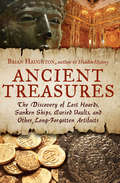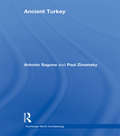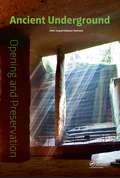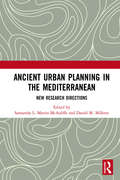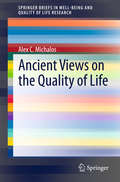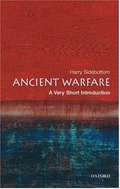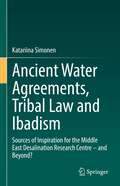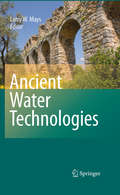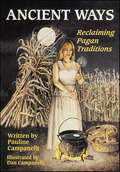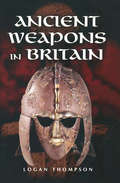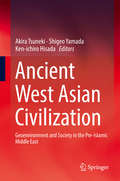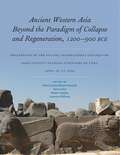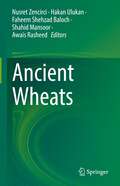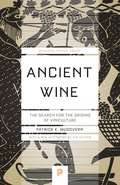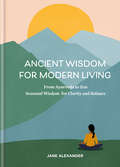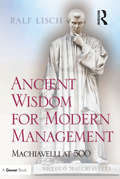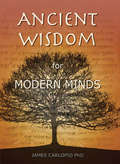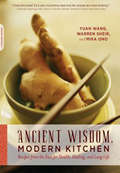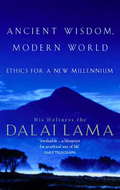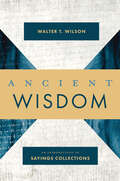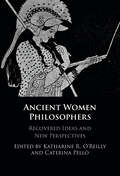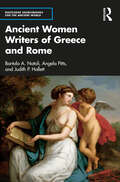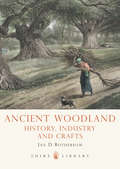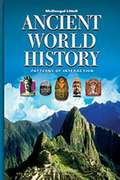- Table View
- List View
Ancient Treasures: The Discovery of Lost Hoards, Sunken Ships, Buried Vaults, and Other Long-Forgotten Artifacts
by Brian HaughtonWhy are so many people fascinated by treasure? Is it purely a desire for wealth, or is it also the romantic appeal of tales of lost ancient artifacts?It is certainly true that the stories behind the loss and recovery of a number of ancient treasures read like edge-of-the-seat fiction, somewhere between Indiana Jones and James Bond.In Ancient Treasures, you will read fascinating stories of lost hoards, looted archaeological artifacts, and sunken treasures, including:The Sevso Treasure, a hoard of large silver vessels from the late Roman Empireestimated to be worth $200 millionlooted in the 1970s and sold on the black market.The Amber Room, a complete chamber decoration of amber panels backed with gold leaf and mirrors, stolen by the Nazis in 1941 and brought to the castle at Knigsberg in Russia, from which it disappeared.The fabulous wealth of Roman and Viking hoards buried in the ground for safekeeping, only to be unearthed centuries later by humble metal detectorists.The wrecks of the Spanish treasure fleets, whose New World plunder has been the target of elaborate salvage attempts by modern treasure hunters
Ancient Turkey (Routledge World Archaeology)
by Antonio Sagona Paul ZimanskyStudents of antiquity often see ancient Turkey as a bewildering array of cultural complexes. Ancient Turkey brings together in a coherent account the diverse and often fragmented evidence, both archaeological and textual, that forms the basis of our knowledge of the development of Anatolia from the earliest arrivals to the end of the Iron Age. Much new material has recently been excavated and unlike Greece, Mesopotamia, and its other neighbours, Turkey has been poorly served in terms of comprehensive, up-to-date and accessible discussions of its ancient past. Ancient Turkey is a much needed resource for students and scholars, providing an up-to-date account of the widespread and extensive archaeological activity in Turkey. Covering the entire span before the Classical period, fully illustrated with over 160 images and written in lively prose, this text will be enjoyed by anyone interested in the archaeology and early history of Turkey and the ancient Near East.
Ancient Underground Opening and Preservation: Proceedings of the International Symposium on Scientific Problems and Long-term Preservation of Large-scale Ancient Underground Engineering (23-26 October 2015, Longyou, Zhejiang, China)
by Zhifa Yang Chikaosa TanimotoAncient Underground Opening and Preservation contains 59 papers presented at the International Symposium on Scientific Problems and Long-term Preservation of Largescale Ancient Underground Engineering (Longyou, China, 23-26 October 2015). The contributions focus on scientific and technical issues related to long-term preservation of large-scale anc
Ancient Urban Planning in the Mediterranean: New Research Directions
by Samantha L. Martin-McAuliffe Daniel M. MilletteNew Directions in Urban Planning in the Ancient Mediterranean assembles the most up-to-date research on the design and construction of ancient cities in the wider Mediterranean. In particular, this edited collection reappraises and sheds light on ’lost’ Classical plans. Whether intentional or not, each ancient plan has the capacity to embody specific messages linked to such notions as heritage and identity. Over millennia, cities may be divested of their buildings and monuments, and can experience periods of dramatic rebuilding, but their plans often have the capacity to endure. As such, this volume focuses on Greek and Roman grid traces - both literal and figurative. This rich selection of innovative studies explores the ways that urban plans can assimilate into the collective memory of cities and smaller settlements. In doing so, it also highlights how collective memory adapts to or is altered by the introduction of re-aligned plans and newly constructed monuments.
Ancient Views on the Quality of Life (SpringerBriefs in Well-Being and Quality of Life Research)
by Alex C. MichalosThis monograph describes the contributions to our current understanding of quality of life made by the most important ancient philosophers in the Western Tradition. It does so from the point of view of a contemporary researcher in quality of life or human well-being. Revisiting ancient texts from about 600 BCE to 300 BCE, the book explores the earliest ideas in recorded western philosophical and scientific history that were significantly related to current research and understanding of the quality of life or well-being for individuals and communities. It examines the problems and solutions found in these texts and their connection to still current fundamental issues and questions such as: 'What is a good life?', 'What is the best sort of person to be?' 'How can one tell if one's society is making progress to some sort of desirable state or falling backwards?' The book shows that across time and across many cultures, the human species bears some remarkable similarities.
Ancient Warfare: A Very Short Introduction
by Harry SidebottomGreek and Roman warfare was unlike that of any other culture before or since. The key difference is often held to be that the Greeks and Romans practiced a "Western Way of War," in which the aim is an open, decisive battle--won by courage instilled, in part, by discipline. Here, Harry Sidebottom looks at how this Western Way of War was constructed and maintained by the Greeks and Romans and why this concept is so prevalent today. All aspects of ancient warfare are thoroughly examined--from philosophy and strategy to the technical skills needed to fight. Sidebottom examines war in the wider context, showing how wars were able to shape classical society, and how an individual's identity was sometimes constructed by war, as in the case of the Christian soldier fighting in God's name. He also explores the ways in which ancient society thought about conflict: Can a war be just? Why was siege warfare particularly bloody? What role did divine intervention play in the outcome of a battle? Taking fascinating examples from the Iliad, Tacitus, and the Persian Wars, Sidebottom uses arresting anecdotes and striking visual images to show that any understanding of ancient war is an ongoing process of interpretation.
Ancient Water Agreements, Tribal Law and Ibadism: Sources of Inspiration for the Middle East Desalination Research Centre – and Beyond?
by Katariina SimonenThis book traces the development of Oman's inclusive agreements and highlights their importance for international negotiations, dealing with issues most relevant to humanity's own survival today, nuclear weapons or climate change.In Oman, a historical seafaring nation on the south-eastern corner of the Arabian Peninsula, a culture of agreement that accommodates the interests of everyone has developed around the division of scarce water resources.Life in the arid inland of the Omani Hajar mountains would not have been possible without water. Irrigation channel (falaj) construction is extremely old and skilful therein. Local practices evolved around the division of water and land on the basis of fairness. The community would be best served by inclusion and the avoidance of conflict.A specific Islamic school called Ibadi arrived at Oman early on in the eighth century. Ibadi scholars conserved local practices. Consultation and mediation by sheikhs and the religious leader, Imam, became the law of the land. The Omanis were known as the People of Consultation, Ahl Al Shura. In time, the practice of inclusive agreements would extend far beyond the village level, affecting Oman´s foreign policy under Sultan Qaboos. Oman´s water diplomacy succeeded in uniting the contestants of the Middle East Peace Process in the 1990s to work together on common problems of water desalination.
Ancient Water Technologies
by L. MaysThere is no more fundamental resource than water. The basis of all life, water is fast becoming a key issue in today's world, as well as a source of conflict. This fascinating book, which sets out many of the ingenious methods by which ancient societies gathered, transported and stored water, is a timely publication as overextraction and profligacy threaten the existence of aquifers and watercourses that have supplied our needs for millennia. It provides an overview of the water technologies developed by a number of ancient civilizations, from those of Mesopotamia and the Indus valley to later societies such as the Mycenaeans, Minoans, Persians, and the ancient Egyptians. Of course, no book on ancient water technologies would be complete without discussing the engineering feats of the Romans and Greeks, yet as well as covering these key civilizations, it also examines how ancient American societies from the Hohokams to the Mayans and Incas husbanded their water supplies. This unusually wide-ranging text could offer today's parched world some solutions to the impending crisis in our water supply. "This book provides valuable insights into the water technologies developed in ancient civilizations which are the underpinning of modern achievements in water engineering and management practices. It is the best proof that "the past is the key for the future." Andreas N. Angelakis, Hellenic Water Supply and Sewerage Systems Association, Greece "This book makes a fundamental contribution to what will become the most important challenge of our civilization facing the global crisis: the problem of water. Ancient Water Technologies provides a complete panorama of how ancient societies confronted themselves with the management of water. The role of this volume is to provide, for the first time on this issue, an extensive historical and scientific reconstruction and an indication of how traditional knowledge may be employed to ensure a sustainable future for all." Pietro Laureano, UNESCO expert for ecosystems at risk, Director of IPOGEA-Institute of Traditional Knowledge, Italy
Ancient Ways: Reclaiming the Pagan Tradition
by Pauline CampanelliPauline and Dan Campanelli's classic companion to Wheel of the Year is back for a new generation of readers to enjoyCelebrate the seasons of the year according to the ancient Pagan traditions. Ancient Ways shows how to prepare for and conduct the Sabbat rites, and helps you harness the magickal energy for weeks afterward. The wealth of seasonal rituals and charms within are drawn from ancient sources but are easily performed with readily available materials.Learn how to look into your previous lives at Yule. At Beltane, discover the places where you are most likely to see faeries. Make special jewelry to wear for your Lammas celebrations. For the special animals in your life, paint a charm of protection at Midsummer.Most Pagans feel that the Sabbat rituals are all too brief and wish for the magick to continue. Ancient Ways can help you reclaim your own traditions and heighten the feeling of magick all year long.Praise: "A delightful, joyous guide to celebrating the seasons and festivals with homespun magic." —Scott Cunningham, author of Cunningham's Encyclopedia of Magical Herbs "A delightful book that beautifully complements the authors' Wheel of the Year." —Ray Buckland, author of Practical Candleburning Rituals
Ancient Weapons in Britain
by Logan ThompsonA groundbreaking study of the weaponry used in combat thousands of years ago. Few accounts of ancient warfare have looked at how the weapons were made and how they were actually used in combat. Logan Thompson's pioneering survey traces the evolution of weapons in Britain across three thousand years, from the Bronze Age to the Battle of Hastings in 1066. Insights gained from painstaking practical research and technical analysis shed new light on the materials used, the processes of manufacture, the development of the weapons, and their effectiveness. His account features new information about the weapons themselves and their origin and design—as well as a fascinating new perspective on the practice of early warfare.
Ancient West Asian Civilization: Geoenvironment and Society in the Pre-Islamic Middle East
by Akira Tsuneki Shigeo Yamada Ken-Ichiro HisadaThis book explores aspects of the ancient civilization in West Asia, which has had a great impact on modern human society--agriculture, metallurgy, cities, writing, regional states, and monotheism, all of which appeared first in West Asia during the tenth to first millennia BC. The editors specifically use the term "West Asia" since the "Middle East" is seen as an Eurocentric term. By using this term, the book hopes to mitigate potential bias (i. e. historical and Western) by using a pure geographical term. However, the "West Asia" region is identical to that of the narrower "Middle East," which encompasses modern Iran and Turkey from east to west and Turkey and the Arabian Peninsula from north to south. This volume assembles research from different disciplines, such as the natural sciences, archaeology and philology/linguistics, in order to tackle the question of which circumstances and processes these significant cultural phenomena occurred in West Asia. Scrutinizing subjects such as the relations between climate, geology and human activities, the origins of wheat cultivation and animal domestication, the development of metallurgy, the birth of urbanization and writing, ancient religious traditions, as well as the treatment of cultural heritage, the book undertakes a comprehensive analysis of West Asian Civilization that provided the common background to cultures in various areas of the globe, including Europe and Asia. These contributions will attempt to demonstrate a fresh vision which emphasizes the common cultural origin between Europe and West Asia, standing in opposition to the global antagonism symbolized by the theory of "Clash of Civilizations. "
Ancient Western Asia Beyond the Paradigm of Collapse and Regeneration: Proceedings of the NYU-PSL International Colloquium, Paris Institut National d’Histoire de l’Art, April 16–17, 2019 (ISAW Monographs)
by Maria Grazia Masetti-Rouault, Ilaria Calini, Robert Hawley, and Lorenzo d’AlfonsoNew results and interpretations challenging the notion of a uniform, macroregional collapse throughout the Late Bronze Age Eastern MediterraneanAncient Western Asia Beyond the Paradigm of Collapse and Regeneration (1200–900 BCE) presents select essays originating in a two-year research collaboration between New York University and Paris Sciences et Lettres. The contributions here offer new results and interpretations of the processes and outcomes of the transition from the Late Bronze Age to the Iron Age in three broad regions: Anatolia, northern Mesopotamia, and the Levant. Together, these challenge the notion of a uniform, macroregional collapse throughout the Eastern Mediterranean, followed by the regeneration of political powers. Current research on newly discovered or reinterpreted textual and material evidence from Western Asia instead suggests that this transition was characterized by a diversity of local responses emerging from diverse environmental settings and culture complexes, as evident in the case studies collected here in history, archaeology, and art history. The editors avoid particularism by adopting a regional organization, with the aim of identifying and tracing similar processes and outcomes emerging locally across the three regions. Ultimately, this volume reimagines the Late Bronze–Iron Age transition as the emergence of a set of recursive processes and outcomes nested firmly in the local cultural interactions of western Asia before the beginning of the new, unifying era of Assyrian imperialism.
Ancient Wheats
by Nusret Zencirci Hakan Ulukan Faheem Shehzad Baloch Shahid Mansoor Awais RasheedWheat (Triticum L.), an annual herbaceous plant in Poacae (Gramineae) family, settles in the Triticeae (Hordeae) subfamily. The grasses (Poaceae Barnhart) are the fifth largest (monocotyledonous flowering) plant family and of great importance for human civilization and life. Cereal crops such as maize, wheat, rice, barley, and millet are the domesticated ones in the family. It is still the most vital economical plant family in modern times, providing food, forage, building materials (bamboo, thatch), and fuel (ethanol). Wheat has many accessions in national and international gene banks. The estimated number of wheats by FAO in 2010 is 856,000, and, followed by rice (774,000), and barley (467,000). However, the recent consumer's (misdirected) focus on gluten content and nutritional value urges scientists to reexamine their knowledge about wheat (i.e., origin, evolution, and general and special quality characteristics), as well as their wild relatives and landraces for newer possible genetic resources. Cultured or non-cultured ancestral wheats: einkorn, emmer, wild emmer, spelt, macha, and vavilovii are still limitedly grown on the higher areas in Turkey, Italy, Germany, Morocco, Israel, and Balkan countries. They are exploited mostly for their desired agronomic, and specific quality. In some cultures, wheat species are believed to be therapeutic, with bioactive compounds that reduce and inhibit stubborn illnesses such as diabetes, cancer, Alzheimer, and cardiovascular diseases. In this book, we summarize the importance of ancestral wheat species, and provide a prospect for their future with special considerations in terms of species conservation and improvement.
Ancient Wine: The Search for the Origins of Viniculture (Princeton Science Library #66)
by Patrick E. McGovernA richly illustrated account of the story of ancient vinicultureThe history of civilization is, in many ways, the history of wine. This book is the first comprehensive account of the earliest stages of the history and prehistory of viniculture, which extends back into the Neolithic period and beyond. Elegantly written and richly illustrated, Ancient Wine opens up whole new chapters in the fascinating story of wine by drawing on recent archaeological discoveries, molecular and DNA sleuthing, and the writings and art of ancient peoples. In a new afterword, the author discusses exciting recent developments in the understanding of ancient wine, including a new theory of how viniculture came to central and northern Europe.
Ancient Wisdom for Modern Living: From Ayurveda to Zen: Seasonal Wisdom for Clarity and Balance
by Jane AlexanderJane Alexander is inspired and inspiring. I trust her advice completely' - Sarah Stacey, Mail on SundayIn this fast-paced, social media-filled world, people are looking for clarity and inner calm, as well as an escape from the digital overload. This book offers a comprehensive lowdown on the ancient wisdoms from around the world in an accessible way, so we can harness this wisdom and use it in our contemporary environment. The book will be broken down into five major sections. The first gives an overview to the various forms of ancient wisdom covered in the book. The following four sections will each cover a season with information and practical exercises on: Nutrition (adapting your diet throughout the year); Body (different seasonal exercise, including simple yoga and qiyong flows, healing forms of breathwork and bodywork); Emotional life (seasonal emotional shifts and advice on natural approaches to dealing with everyday stresses and anxiety); and Spiritual life (powerful soul-work, including crystals, sound healing and oracles).
Ancient Wisdom for Modern Management: Machiavelli at 500
by Ralf LischMachiavelli lives. 500 years after Niccolò Machiavelli has written 'The Prince', this classic of the mechanisms behind success in management has not lost its relevance. In an intriguing and inspiring interplay of quotes, interpretations and examples, Dr Ralf Lisch develops Machiavelli's most famous work into a practical guide providing Ancient Wisdom for Modern Management. Many have heard about Machiavelli but few have really read and understood him. Ralf Lisch's analysis of ’The Prince’ proves that widespread associations with evil management are a thorough misunderstanding. He has done away with historic ballast and abstains from a moralizing approach that does not do justice to Machiavelli's works. Instead, he lets Machiavelli have his say and provides a positive and pragmatic interpretation of the wisdom of 'The Prince' from a management perspective. It is a fresh approach that combines theoretical analysis with a practical focus. Dealing with a wide range of essential management topics like careers, success, intellect, decision-making, trust, change management, knowledge management, mergers and acquisitions, networking, sustainability, business ethics, working processes and many others, this book proves that the basics of management have hardly changed over half a millennium. Ancient Wisdom for Modern Management is an amazing insight into the essentials of management and a workable guidance to success in daily business. This open-minded and compelling exploration of 'The Prince' combines reading pleasure with a great opportunity to participate in Machiavelli's truly timeless wisdom.
Ancient Wisdom for Modern Minds: A Thinking Heart and a Feeling Mind
by James CarlopioThoughts, reflections and experiences voiced by ancient sages appear in this book as 'coaching conversations'. Their wisdom creates a vibrant landscape populated with insights which help us to reflect upon and discuss emotions encountered in personal transformation and constant workplace change. They allow us to process past experiences and emotions in order to move on. James Carlopio shows us that coaching for personal improvement has occurred since time-immemorial. These ancient quotes illuminate modern-day socio-cognitive constructs and techniques used in coaching psychology. The 'coaching conversation' itself is grounded in the constructivist-narrative approaches used within Solution-Focused Brief Therapy. These ancient quotes will assist readers to undergo personal transitions, Executive Coaches to facilitate workplace change and Life Coaches in personal development. Positive Psychology and important areas in coaching psychology are referenced in the Introduction and section openings. Supported by a subject index, this luminous work is grouped into sections addressing: awareness of self and others life, death, health and happiness wisdom, communication and learning achievement, goals and effort The text is designed to help people access emotion, express emotion, acknowledge emotion, release emotion and move on gracefully to happier, more successful and less stressed lives.
Ancient Wisdom, Modern Kitchen: Recipes from the East for Health, Healing, and Long Life
by Yuan Wang Warren SheirAward-Winner in the Cookbooks: International category of the 2010 International Book Awards Ancient Wisdom, Modern Kitchen reveals how easy it is to tap into the 3,000-year-old secrets of the Eastern healing arts. This entertaining and easy-to-use book provides scores of delicious recipes, anecdotes about various herbs and foods, and all you need to know about acquiring ingredients--even if you don't know the difference between a lotus seed and the lotus position. Highlighting "superfoods," such as goji berries, as well as more familiar ingredients like ginger, garlic, and mint, Ancient Wisdom, Modern Kitchen includes indispensible information: * An overview of traditional Chinese medicine, herbs, and food therapy * Details on 100 healthy Asian ingredients * Healing recipes for common health concerns, including fatigue, menopause, high cholesterol, weight control, and diabetes
Ancient Wisdom, Modern World: Ethics for the New Millennium
by The Dalai Lama Alexander NormanAt a time and in a culture where science and technology have taken over from religious belief, when ethics are understood primarily in terms of aesthetic choice or legality, how are we to formulate moral principles to guide us in our daily lives? Though religion can certainly help in this, the Dalai Lama demonstrates that there are universal principles we can draw on which transcend the dilemma of belief or unbelief. And whilst many have been content to speak of spiritual matters as something mysterious or evanescent, the Dalai Lama explains his approach in terms that are as clear and concise as they are compelling. With wit, gentle good sense and with penetrating insight, the Dalai Lama shows how the truths that have stood the test of generations of practise can provide us with the tools to live happy, fulfilled and meaningful lives. In the process, it becomes apparent that he does not merely espouse the 'feelgood' religiosity some accuse him of. The reader is left admiring not just the wisdom of the author, but the wisdom of the culture he represents.
Ancient Wisdom, Modern World: Ethics for the New Millennium
by Alexander Norman His Holiness The Dalai LamaAt a time and in a culture where science and technology have taken over from religious belief, when ethics are understood primarily in terms of aesthetic choice or legality, how are we to formulate moral principles to guide us in our daily lives? Though religion can certainly help in this, the Dalai Lama demonstrates that there are universal principles we can draw on which transcend the dilemma of belief or unbelief. And whilst many have been content to speak of spiritual matters as something mysterious or evanescent, the Dalai Lama explains his approach in terms that are as clear and concise as they are compelling. With wit, gentle good sense and with penetrating insight, the Dalai Lama shows how the truths that have stood the test of generations of practise can provide us with the tools to live happy, fulfilled and meaningful lives. In the process, it becomes apparent that he does not merely espouse the 'feelgood' religiosity some accuse him of. The reader is left admiring not just the wisdom of the author, but the wisdom of the culture he represents.
Ancient Wisdom: An Introduction to Sayings Collections (Wisdom Literature From The Ancient World Ser. #1)
by Walter T. WilsonThis book surveys and analyzes twenty-seven major collections of wisdom sayings from antiquity, including texts from ancient Egypt, the ancient Near East, ancient Israel and early Judaism, early Christianity, and the Greco-Roman world. Through the diversity of these selections, readers are exposed to wisdom literature from a wide array of historical, cultural, and linguistic settings, which unfolds into a larger understanding of how different ancient peoples articulated a gnomic understanding of life. Throughout this useful guide, Walter Wilson keeps a constant eye on the relation of the wisdom texts to the worlds from which they emerged—paying close attention to each text&’s distinctive thematic profile and how its moral agenda was mapped onto the reader&’s social landscape. Where appropriate, he discusses affinities between the different collections and draws conclusions about ancient wisdom literature as a genre. For further study, each entry includes a short bibliography directing the reader to an up-to-date translation of the collection in question and other relevant secondary texts, making this an ideal starting point for anyone studying wisdom literature of the ancient world.
Ancient Women Philosophers: Recovered Ideas and New Perspectives
by Caterina Pellò Katharine R. O’ReillyDespite the common misconception that ancient philosophy was the domain of male thinkers, sources confirm that ancient women engaged in philosophical activity. Bringing together a collection of essays on ancient women thinkers, with special focus on their ideas and contributions to the history of philosophy, this volume is about the earliest women philosophers, their breakthroughs, and the methods we can use to excavate them. The essays survey the methodological strategies we can use to approach the surviving evidence, retrieve the largely unresearched thought and the original ideas of ancient women philosophers, and carve out a space for them in the canon. The broad focus includes women thinkers in ancient Indian, Chinese, and Arabic philosophy as well as in the Greek and Roman philosophical traditions. The volume will be valuable for a wide range of researchers, teachers, and students of ancient philosophy.
Ancient Women Writers of Greece and Rome (Routledge Sourcebooks for the Ancient World)
by Judith P. Hallett Bartolo A. Natoli Angela PittsAncient Women Writers of Greece and Rome features the extant writings of major female authors from the Greco-Roman world, brought together for the first time in a single volume, in both their original languages and translated into English with accompanying commentaries. The most cost-effective and comprehensive way to study the women writers of Greece and Rome, this book provides original texts, accessible text-commentaries, and detailed English translations of the works of ancient female poets and authors such as Sappho and Sulpicia. It takes a student-focused approach, discussing texts alongside new and original English translations and highlighting the rich, diverse scholarship on ancient women writers to specialists and non-specialists alike. The perspectives of women in the ancient world are still relevant and of interest today, as issues of gender and racial (in)equality remain ever-present in modern society. Ancient Women Writers of Greece and Rome provides a valuable teaching tool for students of Greek, Latin, and Classical Studies, as well as those interested in ancient literature, history, and gender studies who do not have proficiency in Greek or Latin.
Ancient Woodland: History, Industry and Crafts
by Ian RotherhamCONTRARY TO POPULAR BELIEF, Britain's ancient woodlands are not 'wildwoods', or even remnants of 'wildwood'. These truly cultural landscapes mix nature and human history, woven as uniquely rich tapestries of ecology and history. The story of the woods is there to be 'read' if you have time, enthusiasm, and this book, which will take you from prehistory to the present day.
Ancient World History: Patterns of Interaction
by Larry S. Krieger Roger B. Beck Linda Black Phillip C. Naylor Dahia Ibo ShabakaNIMAC-sourced textbook
